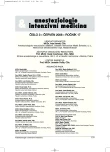Assessment of performance of NMT stimulators used during anaesthesia in the Czech Republic
Test přístrojů používaných v České republice k monitorování nervosvalového přenosu v anesteziologii
Cíl studie:
Zhodnocení kvality přístrojů, používaných v České republice k monitorování nervosvalového přenosu během anestezie. Vyhodnocení, zda stimulátory pracují jako generátory konstantního proudu.
Typ studie:
Laboratorní, prospektivní, kontrolovaná studie.
Název a sídlo pracoviště:
Klinika anesteziologie a resuscitace, Fakultní nemocnice a Lékařská fakulta Univerzity Palackého v Olomouci.
Materiál a metoda:
Testovali jsme šest v České republice komerčně dostupných periferních nervových stimulátorů. Každý stimulátor jsme nechali pracovat do zátěže mezi 50 a 10000 ohmy (režim jednotlivého impulzu, proud od 10 do 60 mA). Na základě Ohmova zákona a osciloskopicky změřeného napětí na zátěži jsme určili skutečnou intenzitu proudu. Stanovili jsme tak zatěžovací charakteristiku všech stimulátorů. Osciloskopicky jsme zachytili tvar stimulační křivky v režimu jednotlivého impulzu. V každé měřené kategorii jsme seřadili přístroje od nejlepšího po nejhorší pro souhrnné srovnání.
Výsledky:
Nejpřesnější stimulační proud poskytovaly přístroje TOF-Guard® (Biometer) a TOF-Watch® SX (Organon). Přesnost všech stimulátorů (kromě Innervatoru NS252®, Fisher-Paykel) klesala s rostoucím stimulačním proudem. Nejkvalitnější tvar stimulační křivky dodával Multistim LA (Pajunk), jeden testovaný přístroj (AS/3™, Datex-Ohmeda) umožňuje jak akcelerometrické, tak elektromyografické vyhodnocení svalové odpovědi.
Závěr:
Všechny testované přístroje byly výrobcem deklarovány jako generátory konstantního proudu, podle výsledků testu však toto kritérium některé přístroje nesplňovaly (ParaGraph®, Vital Signs).
Klíčová slova:
nervosvalový přenos – periferní nervový stimulátor – monitorování – stimulační vzorec
Authors:
M. Adamus 1; P. Adamus 2; R. Bělohlávek 3; M. Ludma 3; P. Hropko 3
Authors‘ workplace:
Klinika anesteziologie a resuscitace, Fakultní nemocnice a Lékařská fakulta Univerzity Palackého, Olomouc
1; Rapid System, s. r. o., Olomouc
2; Katedra informatiky, Přírodovědecká fakulta Univerzity Palackého, Olomouc
3
Published in:
Anest. intenziv. Med., 17, 2006, č. 3, s. 145-155
Category:
Anaesthesiology - Original Paper
Overview
Objective:
To assess the performance of NMT stimulators used during anaesthesia in the Czech Republic. To test the ability of the stimulators to work as “constant-current generators”.
Design:
Laboratory prospective controlled study
Setting:
Department of Anaesthesiology and Intensive Care, University Hospital and Palacky University, Olomouc.
Materials and Methods:
Six commercially available peripheral nerve stimulators were studied in laboratory settings. Each stimulator (single twitch mode, stimulating current 10, 20, 30, 40, 50 and 60 mA, respectively) was set to work at different loading resistance from 50 to 10000 Ohm. Based on the voltage measured on the load and Ohm’s law, the actual intensity of the current was determined. The loading characteristics were specified.The morphology of the stimulating pulse was recorded from the oscillographic screen. The stimulators were ranked from the best to the worst in each category.
Results:
The TOF-Guard® (Biometer) and TOF-Watch® SX (Organon) were the most accurate stimulators in terms of the stimulating current. All stimulators except the Innervator NS252® (Fisher-Paykel) were less precise at higher currents (60 mA) than at lower stimulation intensities (10 mA). Multistim LA (Pajunk) showed the best impulse morphology; one of the stimulators (AS/3™, Datex-Ohmeda) offered both accelerometric and electromyograhic evaluation of muscle response.
Conclusion:
The manufacturers declare all the tested stimulators to be “constatnt-current generators”. Based on the test results, some of the stimulators did not meet this attribute because their output was load-dependent (ParaGraph®, Vital Signs).
Key words:
neuromuscular transmission – peripheral nerve stimulator – monitoring – stimulation pattern
Labels
Anaesthesiology, Resuscitation and Inten Intensive Care MedicineArticle was published in
Anaesthesiology and Intensive Care Medicine

2006 Issue 3
Most read in this issue
- Surfactant – use in adult patients
- A comparison of haemodynamic changes using thoracic epidural anesthesia versus standard balanced anaesthesia during on-pump coronary artery bypass grafting
- Assessment of regional tissue perfusion by indicator microdialysis technique
- Assessment of performance of NMT stimulators used during anaesthesia in the Czech Republic
